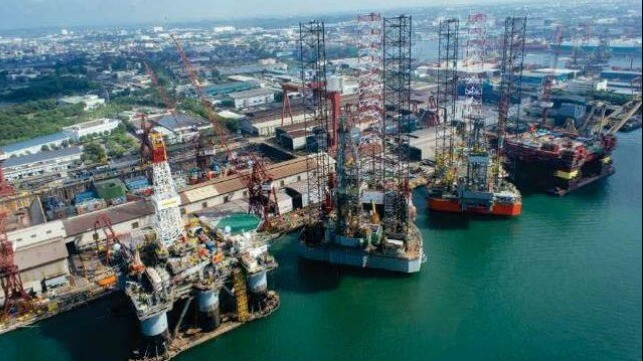Sembcorp Marine to Buy Keppel O&M in Revised Megamerger

Nearly two years after Keppel O&M announced plans to exit its core business in offshore oil rig construction and repairs and six months after an agreement to form a new company with Sembcorp, the planned merger has been restructured for Sembcorp Marine to directly acquire Keppel O&M. The deal, which is now valued at nearly $3.2 billion, provides for a simpler structure and a faster completion so that the companies can respond to the rapidly evolving offshore market.
The offshore rig business was hard hit by a prolonged downturn that was further compounded by the COVID-19 pandemic. In response to market conditions, Keppel O&M announced in January 2021 plans to exit its core offshore rig construction and repair business and refocus its operations on renewables. Five months later, Keppel and Sembcorp Marine announced that they were exploring a merger to create a combined company better suited to address the changing market.
Nearly a year later, in April 2022 the companies agreed to the terms of the megamerger. According to the two rig builders, the combined company would be well-prepared to compete for future opportunities arising from decarbonization in the oil & gas sector and the global energy transition towards renewables. They highlighted the opportunity to reposition to realize opportunities that could include infrastructure for wind, hydrogen, and ammonia markets.
Announcing the agreement to restructure the merger into a direct acquisition of Keppel O&M by Sembcorp Marine, the companies pointed to the improving conditions in the O&M sector in the past six months driven by the rebound in the oil & gas sector due to the ban on Russian energy products and the rebound in energy prices. Both companies have won new contracts in the past few months but at the same time, rising interest rates and other economic volatility have created further pressures which the companies said can be best addressed by accelerating the completion of the combination. The enlarged Sembcorp Marine they believe will be in a better position to deal with the market and economic challenges and compete globally.
“The simplified transaction structure substantially lessens transaction complexity and minimizes certain third-party consent requirements, including from lenders. This could reduce the time to completion by up to two months,” the companies said in announcing the new terms. They noted the earlier terms required consent from certain third parties and approval from voting shareholders representing a majority in headcount holding at least 75 percent in value, all of which no longer apply. They believe the transaction can now be completed by the end of 2022.
Reflecting the changing market conditions and the new structure of the transaction, the valuation of Keppel O&M was lowed by nearly $270 million. As a result, Sembmarine's shareholders will hold a slightly larger 46 percent stake of the combined company versus 44 percent in the previous structure, with Keppel O&M’s investors now holding 54 percent of the company. Keppel also agreed to lower its retained interest to 5 percent versus the previous 10 percent. As with the prior terms, Keppel O&M will retain and sell separately its legacy rigs and associated receivables, as well as certain out-of-scope assets comprising mainly Keppel O&M’s interests in Floatel International and Dyna-Mac Holdings, which will be retained by Keppel.
“With the Proposed Combination, we hope to preserve Singapore’s marine and offshore engineering ecosystem and the industry’s core capabilities developed over the decades by two homegrown companies that have become established global players,” said Tan Sri Mohd Hassan Marican, Chairman of Sembcorp Marine. “An enlarged Sembcorp Marine is better positioned to advance Singapore’s O&M and maritime interests and augment the sector’s potential as a growth engine for the economy, providing jobs and business opportunities, as well as spearhead the nation’s expansion into the adjacent offshore renewables and new energy markets, in tandem with the global transition to a low-carbon economy.”
